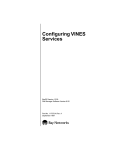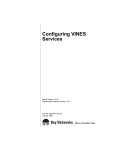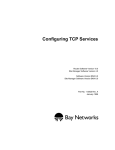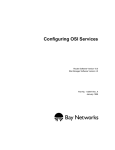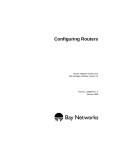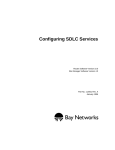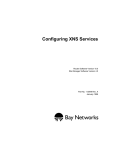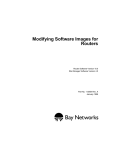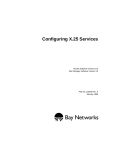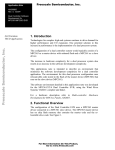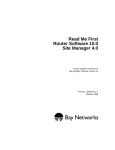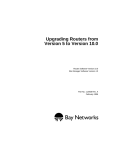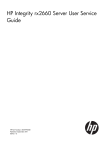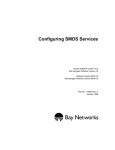Download Avaya Configuring VINES Services User's Manual
Transcript
Configuring VINES Services Router Software Version 10.0 Site Manager Software Version 4.0 Part No. 112948 Rev. A January 1996 4401 Great America Parkway Santa Clara, CA 95054 8 Federal Street Billerica, MA 01821 Copyright © 1988–1996 Bay Networks, Inc. All rights reserved. Printed in the USA. January 1996. The information in this document is subject to change without notice. The statements, configurations, technical data, and recommendations in this document are believed to be accurate and reliable, but are presented without express or implied warranty. Users must take full responsibility for their applications of any products specified in this document. The information in this document is proprietary to Bay Networks, Inc. The software described in this document is furnished under a license agreement and may only be used in accordance with the terms of that license. A summary of the Software License is included in this document. Restricted Rights Legend Use, duplication, or disclosure by the United States Government is subject to restrictions as set forth in subparagraph (c)(1)(ii) of the Rights in Technical Data and Computer Software clause at DFARS 252.227-7013. Notice for All Other Executive Agencies Notwithstanding any other license agreement that may pertain to, or accompany the delivery of, this computer software, the rights of the United States Government regarding its use, reproduction, and disclosure are as set forth in the Commercial Computer Software-Restricted Rights clause at FAR 52.227-19. Trademarks of Bay Networks, Inc. ACE, AFN, BCN, BLN, BN, CN, FRE, LN, Optivity, SynOptics, SynOptics Communications, Wellfleet and the Wellfleet logo are registered trademarks and AN, ANH, ASN, BaySIS, BayStack, BCNX, BLNX, BNX, EZ Internetwork, EZ LAN, FN, PathMan, PhonePlus, PPX, Quick2Config, RouterMan, SPEX, Bay Networks, Bay Networks Press, the Bay Networks logo and the SynOptics logo are trademarks of Bay Networks, Inc. Third-Party Trademarks All other trademarks and registered trademarks are the property of their respective owners. Statement of Conditions In the interest of improving internal design, operational function, and/or reliability, Bay Networks, Inc. reserves the right to make changes to the products described in this document without notice. Bay Networks, Inc. does not assume any liability that may occur due to the use or application of the product(s) or circuit layout(s) described herein. Portions of the code in this software product are Copyright © 1988, Regents of the University of California. All rights reserved. Redistribution and use in source and binary forms of such portions are permitted, provided that the above copyright notice and this paragraph are duplicated in all such forms and that any documentation, advertising materials, and other materials related to such distribution and use acknowledge that such portions of the software were developed by the University of California, Berkeley. The name of the University may not be used to endorse or promote products derived from such portions of the software without specific prior written permission. SUCH PORTIONS OF THE SOFTWARE ARE PROVIDED “AS IS” AND WITHOUT ANY EXPRESS OR IMPLIED WARRANTIES, INCLUDING, WITHOUT LIMITATION, THE IMPLIED WARRANTIES OF MERCHANTABILITY AND FITNESS FOR A PARTICULAR PURPOSE. In addition, the program and information contained herein are licensed only pursuant to a license agreement that contains restrictions on use and disclosure (that may incorporate by reference certain limitations and notices imposed by third parties). Bay Networks Software License Note: This is Bay Networks basic license document. In the absence of a software license agreement specifying varying terms, this license — or the license included with the particular product — shall govern licensee’s use of Bay Networks software. This Software License shall govern the licensing of all software provided to licensee by Bay Networks (“Software”). Bay Networks will provide licensee with Software in machine-readable form and related documentation (“Documentation”). The Software provided under this license is proprietary to Bay Networks and to third parties from whom Bay Networks has acquired license rights. Bay Networks will not grant any Software license whatsoever, either explicitly or implicitly, except by acceptance of an order for either Software or for a Bay Networks product (“Equipment”) that is packaged with Software. Each such license is subject to the following restrictions: 1. Upon delivery of the Software, Bay Networks grants to licensee a personal, nontransferable, nonexclusive license to use the Software with the Equipment with which or for which it was originally acquired, including use at any of licensee’s facilities to which the Equipment may be transferred, for the useful life of the Equipment unless earlier terminated by default or cancellation. Use of the Software shall be limited to such Equipment and to such facility. Software which is licensed for use on hardware not offered by Bay Networks is not subject to restricted use on any Equipment, however, unless otherwise specified on the Documentation, each licensed copy of such Software may only be installed on one hardware item at any time. 2. Licensee may use the Software with backup Equipment only if the Equipment with which or for which it was acquired is inoperative. 3. Licensee may make a single copy of the Software (but not firmware) for safekeeping (archives) or backup purposes. 4. Licensee may modify Software (but not firmware), or combine it with other software, subject to the provision that those portions of the resulting software which incorporate Software are subject to the restrictions of this license. Licensee shall not make the resulting software available for use by any third party. 5. Neither title nor ownership to Software passes to licensee. 6. Licensee shall not provide, or otherwise make available, any Software, in whole or in part, in any form, to any third party. Third parties do not include consultants, subcontractors, or agents of licensee who have licensee’s permission to use the Software at licensee’s facility, and who have agreed in writing to use the Software only in accordance with the restrictions of this license. 7. Third-party owners from whom Bay Networks has acquired license rights to software that is incorporated into Bay Networks products shall have the right to enforce the provisions of this license against licensee. 8. Licensee shall not remove or obscure any copyright, patent, trademark, trade secret, or similar intellectual property or restricted rights notice within or affixed to any Software and shall reproduce and affix such notice on any backup copy of Software or copies of software resulting from modification or combination performed by licensee as permitted by this license. Bay Networks, Inc. 4401 Great America Parkway, Santa Clara, CA 95054 8 Federal Street, Billerica, MA 01821 Bay Networks Software License (continued) 9. Licensee shall not reverse assemble, reverse compile, or in any way reverse engineer the Software. [Note: For licensees in the European Community, the Software Directive dated 14 May 1991 (as may be amended from time to time) shall apply for interoperability purposes. Licensee must notify Bay Networks in writing of any such intended examination of the Software and Bay Networks may provide review and assistance.] 10. Notwithstanding any foregoing terms to the contrary, if licensee licenses the Bay Networks product “Site Manager,” licensee may duplicate and install the Site Manager product as specified in the Documentation. This right is granted solely as necessary for use of Site Manager on hardware installed with licensee’s network. 11. This license will automatically terminate upon improper handling of Software, such as by disclosure, or Bay Networks may terminate this license by written notice to licensee if licensee fails to comply with any of the material provisions of this license and fails to cure such failure within thirty (30) days after the receipt of written notice from Bay Networks. Upon termination of this license, licensee shall discontinue all use of the Software and return the Software and Documentation, including all copies, to Bay Networks. 12. Licensee’s obligations under this license shall survive expiration or termination of this license. Bay Networks, Inc. 4401 Great America Parkway, Santa Clara, CA 95054 8 Federal Street, Billerica, MA 01821 Contents About This Guide Audience ........................................................................................................................... xi Before You Begin .............................................................................................................. xi Bay Networks Customer Support .....................................................................................xii CompuServe ..............................................................................................................xii InfoFACTS .................................................................................................................xiii World Wide Web ........................................................................................................xiii How to Get Help ..............................................................................................................xiii Conventions .....................................................................................................................xiv Ordering Bay Networks Publications ............................................................................... xv Acronyms ......................................................................................................................... xv Chapter 1 VINES Overview VINES Networks .............................................................................................................1-1 VINES Architecture ..................................................................................................1-2 VINES Network Addressing .....................................................................................1-4 How the Router for VINES Services Works ....................................................................1-6 VINES Data Link Protocols ......................................................................................1-7 VINES Routing Protocols .........................................................................................1-8 VINES Internet Protocol ....................................................................................1-8 VINES Nonsequenced Routing Update Protocol ............................................1-10 VINES Sequenced Routing Update Protocol ..................................................1-14 VINES Nonsequenced Address Resolution Protocol ......................................1-15 VINES Sequenced Address Resolution Protocol ............................................1-16 VINES Internet Control Protocol ......................................................................1-16 For More Information ....................................................................................................1-17 v Chapter 2 VINES Implementation Notes Enabling VINES on a Synchronous Line ........................................................................2-1 Using the Inverse Address Resolution Protocol for VINES Internet Address Resolution ...............................................................................2-2 Assigning a Network ID to Your Router ...........................................................................2-2 Configuring Routers for Serverless Network Segments .................................................2-2 VINES Security Limitation for Serverless Network Segments .................................2-2 Configuring Routers for Multiple-Hop Topologies ...........................................................2-3 Configuring Routers to Source Route over Token Ring Networks ..................................2-4 Making the Transition from Bridging VINES to Routing VINES .......................................2-5 Fragmentation Protocol and VINES Performance ..........................................................2-7 Help Thy Neighbor Support ............................................................................................2-8 Using Multipath with Load Sharing .................................................................................2-8 Partially Meshed Frame Relay Network Support ............................................................2-8 Avoiding Address Numbering Problems in LNs and CNs ...............................................2-9 Chapter 3 Enabling VINES Services Enabling VINES on an Interface .....................................................................................3-1 Chapter 4 Editing VINES Parameters Accessing VINES Parameters ........................................................................................4-2 Editing VINES Global Parameters ............................................................................4-3 VINES Global Parameter Descriptions ..............................................................4-4 Editing VINES Interface Parameters ........................................................................4-6 VINES Interfaces Parameter Descriptions .........................................................4-7 Deleting VINES from the Router ...................................................................................4-14 Appendix A VINES Default Settings Index vi Figures Figure 1-1. Figure 1-2. Figure 1-3. Figure 1-4. Figure 1-5. Figure 1-6. Figure 1-7. Figure 1-8. Figure 2-1. Figure 2-2. Figure 2-3. Figure 3-1. Figure 3-2. Figure 3-3. Figure 4-1. Figure 4-2. Figure 4-3. VINES Server and Its Clients ...................................................................1-2 VINES Network ........................................................................................1-5 VINES Internet Address Format ..............................................................1-6 VINES Fragmentation Protocol Header ...................................................1-7 VINES Internet Protocol Header ..............................................................1-9 VINES Nonsequenced Routing Update Protocol Header ......................1-11 VINES Nonsequenced Address Resolution Protocol Header ................1-15 VINES Internet Control Protocol Header ...............................................1-16 Routers Configured on a Serverless Network Segment ..........................2-3 Source Routing across a Token Ring Network .........................................2-5 Configuring Multiple Loops in a Bridged Environment .............................2-6 Edit Interface Details Window ..................................................................3-2 Edit Connector Window ............................................................................3-3 Edit SYNC Parameters Window ...............................................................3-3 Configuration Manager Window ...............................................................4-2 Edit VINES Global Parameters Window ...................................................4-3 VINES Interfaces Window ........................................................................4-7 vii Tables Table 1-1. Table 1-2. Table 1-3. Table 4-1. Table A-1. Table A-2. VINES Protocol Stack ..............................................................................1-2 Assignment of Subnetwork Numbers ......................................................1-6 VINES Routing Tables ............................................................................1-12 Broadcast Class Options .........................................................................4-5 VINES Global Parameters ...................................................................... A-1 VINES Interface Parameters ................................................................... A-2 ix About This Guide If you are responsible for customizing Bay Networks router software for VINES services, refer to this guide for • An overview of the VINES routing protocol and a description of how the VINES services work (see Chapter 1, “VINES Overview”) • Implementation notes that may affect how you configure VINES routing services (see Chapter 2, “VINES Implementation Notes”) • Instructions on initially configuring a VINES interface (see Chapter 3, “Enabling VINES Services”) • Instructions on editing VINES global and interface parameters and configuring VINES services (see Chapter 4, “Editing VINES Parameters”) For information and instructions about the following tasks, see Configuring Routers. • • Retrieving a configuration file Rebooting the router with a configuration file Audience Written for system and network managers, this guide describes how to configure the Bay Networks implementation of VINES interfaces to suit your environment. Before You Begin Before using this guide, you must complete the following procedures: • Create and save a configuration file that has at least one VINES interface. • Retrieve the configuration file in local, remote, or dynamic mode. xi Configuring VINES Services Refer to Configuring Bay Networks Routers for instructions. Bay Networks Customer Support Bay Networks provides live telephone technical support to our distributors, resellers, and service-contracted customers from two U.S. and three international support centers. If you have purchased your Bay Networks product from a distributor or authorized reseller, contact the technical support staff of that distributor or reseller for assistance with installation, configuration, troubleshooting, or integration issues. Customers also have the option of purchasing direct support from Bay Networks through a variety of service programs. The programs include priority access telephone support, on-site engineering assistance, software subscription, hardware replacement, and other programs designed to protect your investment. To purchase any of these support programs, including PhonePlus™ for 24-hour telephone technical support, call 1-800-2LANWAN. Outside the U.S. and Canada, call (408) 764-1000. You can also receive information on support programs from your local Bay Networks field sales office, or purchase Bay Networks support directly from your reseller. Bay Networks provides several methods of receiving support and information on a nonpriority basis through the following automated systems. CompuServe Bay Networks maintains an active forum on CompuServe. All you need to join us online is a computer, a modem, and a CompuServe account. We also recommend using the CompuServe Information Manager software, available from CompuServe. The Bay Networks forum contains libraries of technical and product documents designed to help you manage and troubleshoot your Bay Networks products. Software agents and patches are available, and the message boards are monitored by technical staff and can be a source for problem solving and shared experiences. Customers and resellers holding Bay Networks service contracts can visit the special libraries to acquire advanced levels of support documentation and software. xii About This Guide To open an account and receive a local dial-up number, call CompuServe at 1-800-524-3388 and ask for Representative No. 591. • In the United Kingdom, call Freephone 0800-289378. • In Germany, call 0130-37-32. • In Europe (except for the United Kingdom and Germany), call (44) 272-760681. • Outside the U.S., Canada, and Europe, call (614) 529-1349 and ask for Representative No. 591, or consult your listings for an office near you. Once you are online, you can reach our forum by typing the command GO BAYNETWORKS at any ! prompt. InfoFACTS InfoFACTS is the Bay Networks free 24-hour fax-on-demand service. This automated system contains libraries of technical and product documents designed to help you manage and troubleshoot your Bay Networks products. The system can return a fax copy to the caller or to a third party within minutes of being accessed. World Wide Web The World Wide Web (WWW) is a global information system for file distribution and online document viewing via the Internet. You need a direct connection to the Internet and a Web Browser (such as Mosaic or Netscape). Bay Networks maintains a WWW Home Page that you can access at http://www.baynetworks.com. One of the menu items on the Home Page is the Customer Support Web Server, which offers technical documents, software agents, and an E-mail capability for communicating with our technical support engineers. How to Get Help For additional information or advice, contact the Bay Networks Technical Response Center in your area: United States Valbonne, France 1-800-2LAN-WAN (33) 92-966-968 xiii Configuring VINES Services Sydney, Australia Tokyo, Japan (61) 2-903-5800 (81) 3-328-005 Conventions This section describes the conventions used in this guide. angle brackets (< >) Indicate that you choose the text to enter based on the description inside the brackets. Do not type the brackets when entering the command. Example: if command syntax is ping <ip_address>, you enter ping 192.32.10.12 arrow character (➔) Separates menu and option names in instructions. Example: Protocols➔AppleTalk identifies the AppleTalk option in the Protocols menu. bold text Indicates text that you need to enter and command names in text. Example: Use the dinfo command. brackets ([ ]) Indicate optional elements. You can choose none, one, or all of the options. italic text Indicates variable values in command syntax descriptions, new terms, file and directory names, and book titles. quotation marks (“ ”) Indicate the title of a chapter or section within a book. screen text Indicates data that appears on the screen. Example: Set Bay Networks Trap Monitor Filters ellipsis points vertical line (|) . Horizontal (. . .) and vertical ( .. ) ellipsis points indicate omitted information. Indicates that you enter only one of the parts of the command. The vertical line separates choices. Do not type the vertical line when entering the command. Example: If the command syntax is show at routes | nets, you enter either show at routes or show at nets, but not both. xiv About This Guide Ordering Bay Networks Publications To purchase additional copies of this document or other Bay Networks publications, order by part number from Bay Networks Press™ at the following numbers. You may also request a free catalog of Bay Networks Press product publications. Phone: FAX - U.S./Canada: FAX - International: 1-800-845-9523 1-800-582-8000 1-916-939-1010 ARP Address Resolution Protocol HDLC High-level Data Link Control ICMP Internet Control Message Protocol ICP Internet Control Protocol IPC Interprocess Communication IEEE Institute of Electrical and Electronic Engineers IP Internet Protocol ISO International Organization for Standardization MAC media access control OSI Open Systems Interconnection RTP Routing Update Protocol SMDS Switched Multimegabit Data Services SNAP Subnetwork Access Protocol SPP Sequenced Packet Protocol TCP Transmission Control Protocol UDP User Datagram Protocol VINES Virtual Networking System Acronyms xv Chapter 1 VINES Overview This overview of the Virtual Networking System (VINES) looks briefly at • VINES network organization, architecture, and addressing scheme • Router software for VINES services, including the data link and routing protocols VINES Networks Banyan Systems developed VINES as a network for personal computers. Based on UNIX System 5.3, VINES uses a distributed system environment wherein PC users easily communicate and share hardware (such as printers, disk space, and modems) and software (such as files and applications) transparently on a network. To a PC user, VINES presents a complex, multivendor network as if it were a single-vendor network. Resources from all servers on the network are available to individual PCs with system administrators controlling access to those resources. A VINES network employs servers, clients, and various communications hardware connected over LANs and WANs (Figure 1-1): • Servers are computers that run VINES server software to provide connectivity and services, such as file and print services, to PC users. Banyan and several other vendors manufacture VINES server hardware. • Clients are PCs that run VINES client software and use the services provided by servers. 1-1 Configuring VINES Services Client Client Client VINES Server Client Figure 1-1. Client VINES Server and Its Clients Datagrams called VINES internet packets carry information across a VINES environment. Within each packet is the source and destination address needed to route the packet between nodes on the network. Each packet is a discrete unit of data that travels independently on the network layer. VINES Architecture VINES architecture reflects the International Organization for Standardization (ISO) for Open Systems Interconnection (OSI). Banyan designed VINES to support both existing and future OSI model requirements. The VINES protocol stack has seven layers; the lower three layers deliver and route data, while the upper layers handle application-specific processes (Table 1-1). Table 1-1. VINES Protocol Stack Layer Protocol or Application Application VINES services, VINES Tasker, UNIX, DOS, and StreetTalk Presentation VINES Matchmaker Data Type Representations Session VINES Matchmaker Remote Procedure Calls (continued) 1-2 VINES Overview Table 1-1. VINES Protocol Stack (continued) Layer Protocol or Application Transport VINES Interprocess Communication (IPC) Protocol VINES Sequenced Packet Protocol (SPP), Transmission Control Protocol (TCP), and User Datagram Protocol (UDP) Network VINES Internet Protocol (IP) VINES Internet Control Protocol (ICP) VINES Nonsequenced Address Resolution Protocol (ARP) VINES Sequenced ARP VINES Nonsequenced Routing Update Protocol (RTP) VINES Sequenced RTP X.25, X.3, X.29, and IP used by TCP, ICMP, and NetBIOS Data Link VINES Fragmentation Protocol Drivers for Block Asynchronous, High Data Link Control (HDLC), Token Ring, Ethernet, other LANS, and Institute of Electrical and Electronic Engineers (IEEE) 802.x standards Physical Broadband, baseband, point-to-point, and twisted pair At the data link level, VINES currently supports several IEEE standards, including Ethernet, Token Ring, and 802.x. VINES also provides its own proprietary data link protocol, VINES Fragmentation Protocol, which breaks up and reassembles packets that are too large to travel over certain media. However, only routers configured over synchronous lines support VINES Fragmentation Protocol. At the networking level, VINES supports both industry standard protocols such as TCP/IP, X.25, and AppleTalk, and its own set of networking protocols. The latter include VINES • Internet Protocol • Nonsequenced Routing Update Protocol • Sequenced Routing Update Protocol • Nonsequenced Address Resolution Protocol • Sequenced Address Resolution Protocol • Internet Control Protocol Upper layer protocols include VINES print and file service applications and the VINES naming protocol, StreetTalk. 1-3 Configuring VINES Services StreetTalk is a distributed directory service that contains the names and attributes of all critical network resources. Each resource on a VINES network has a StreetTalk name that is globally unique. StreetTalk names have the following format: item@group@organization where item identifies a user or resource on the network group identifies the group to which the item belongs organization identifies the organization to which the group belongs VINES adapts to changes in the network topology; because the VINES network refers to each resource by name, you can move or replace it and the PCs can still locate it. System administrators control which resources end users on the network can access. VINES Network Addressing Each node grouping on a VINES network consists of a service node and the client nodes to which the service node provides address resolution and routing services (Figure 1-2). Note that this is a logical grouping; client nodes may or may not map directly to the same physical media. 1-4 VINES Overview VINES Address 00008A42.8001 PC VINES Address 00008A42.8002 PC VINES Address 00008A42.8003 PC Server 1 Server 2 LAN 20 LAN 50 Serial 8A42 VINES Address 8A42.1 PC VINES Address EC25.8001 PC VINES Address EC25.8002 PC VINES Address EC25.8003 Serial EC25 VINES Address EC25.1 KEY LAN = LANAddress Serial = Serial Number VINESAddress = Network Number.Subnetwork Number Figure 1-2. VINES Network When a client node becomes active on the network, it broadcasts a query request to all servers. All reachable servers respond. The client node chooses the first server that responds and requests a VINES internet address from that server. The service node assigns a unique, 48-bit VINES internet address to the client node. The VINES internet address is independent of any data-link-layer address assigned to a node on a physical medium. The 48-bit VINES internet address consists of two fields (Figure 1-3): • The 32-bit network number field The network number is the serial number of the server node and identifies the logical grouping of nodes on a VINES network. • The 16-bit subnetwork number field The subnetwork number identifies the node within the server node’s logical grouping. 1-5 Configuring VINES Services Network Number Subnetwork Number Client Server 32 bits Figure 1-3. 16 bits VINES Internet Address Format The internet address for each service node in a VINES network is its network number, integrated with the subnetwork number 1. The service node assigns unique internet addresses to all other client nodes in its subnetwork by integrating its network number with a unique subnetwork number for each node. The service node assigns subnetwork numbers as shown in Table 1-2. Table 1-2. Assignment of Subnetwork Numbers Subnetwork Number Node Type 1 Server only 2 to 0x7fff Unused 0x8001 to 0xfffe Clients only ffff Broadcast How the Router for VINES Services Works On a VINES network, the router maintains the network topology and uses both IEEE standard and VINES proprietary protocols to route packets through the network. The router supplies client nodes with addresses only if there are no other servers on the network. The following sections describe the VINES data link and routing protocols that the router uses. 1-6 VINES Overview VINES Data Link Protocols The VINES data link protocols support the exchange and broadcast of data frames between neighboring server and client nodes on the network. The maximum frame size is 1500 bytes. In addition to supporting most of the IEEE standards, the VINES Fragmentation Protocol breaks up packets that are too large to travel over certain media into smaller-sized frames and reassembles them. However, the Fragmentation Protocol supports routers configured over synchronous lines only. For example, if a node on an IBM PC LAN attempts to send a packet to a node on an Ethernet LAN over a synchronous network, the Fragmentation Protocol fragments the packet into smaller-sized frames. This enables the router to transport the packets over an Ethernet LAN. The Fragmentation Protocol has a 2-byte header that stores information and follows the data link header in a VINES frame (Figure 1-4). Bits 0 to 5 Not Used Bit 6 - If set to 1, frame ends a VINES IP packet Bit 7 - If set to 1, frame begins a VINES IP packet Control Field 1 byte Figure 1-4. Sequence Number 1 byte VINES Fragmentation Protocol Header The first byte of the header contains a control field and the second byte contains a sequence number. The value of the control field indicates whether the frame begins or ends in a VINES IP packet. Only the first fragment includes the VINES IP header. The value of the sequence number field is modulo 256. The node that originated the frame determines this value. The receiving node uses this value to determine the correct order in which to reassemble the data packet as it receives fragments. If the receiving node receives the fragments out of order, the intermediate node discards all fragments and the partially reassembled packet. 1-7 Configuring VINES Services VINES Routing Protocols The VINES network layer protocols route VINES data packets to destination nodes using the fastest route available. They also distribute the current network topology throughout the network. The VINES network layer supports connectionless (datagram) services only. The maximum packet length on a VINES network is 1500 bytes, including the VINES Internet Protocol header. The following sections describe our implementation of the VINES networking protocols. These include VINES • Internet Protocol • Nonsequenced Routing Update Protocol • Sequenced Routing Update Protocol • Nonsequenced Address Resolution Protocol • Sequenced Address Resolution Protocol • Internet Control Protocol VINES Internet Protocol VINES Internet Protocol (IP) routes packets from the source node to the destination node. The IP packet header specifies the destination node’s internet address. All internet packets begin with a VINES IP header that identifies the source and destination node addresses, and contains an identifier for the next protocol in the packet, a transport control byte, the length of the entire packet, and a software checksum, if needed. A header for another network layer protocol or transport layer protocol follows the VINES IP header (Figure 1-5). 1-8 VINES Overview Checksum (2 bytes) Packet Length (2 bytes) 18 bytes Transport Control (1 byte) Protocol Type (1 byte) Destination Network Number (4 bytes) Destination Subnetwork Number (2 bytes) Source Network Number (4 bytes) Source Subnetwork Number (2 bytes) Figure 1-5. VINES Internet Protocol Header When the router receives a packet, the VINES IP entity on the router handles the packet according to how it is addressed, as follows: • Packets destined for the router When the router receives a packet addressed to itself, it first reassembles the packet, if it is fragmented. Next, the router ensures that the packet is not corrupted by checking the checksum, if there is one. Finally, it passes the packet up to the next level for processing. 1-9 Configuring VINES Services • Broadcast packets When the router receives a broadcast packet, it checks the packet’s hop count to ensure that it is not zero. In most cases, if the hop count is zero, the router discards the packet (unless it is a StreetTalk or Time Sync Service packet). If the node accepts the packet, the router decrements the hop count by one before retransmitting the packet on all interfaces except for the one that received it. If the broadcast packet is a StreetTalk broadcast packet, which propagates StreetTalk information, or a Time Sync Service broadcast packet, which propagates time information, the router ignores the hop count. First, the router checks to see if the interface that provides the best path back to the originating node received the packet. If it did, the router retransmits the packet on all other interfaces (without modifying the hop-count field). Otherwise, the router determines that the packet has looped back, and discards it. The router recognizes a StreetTalk broadcast packet or a Time Sync Service broadcast packet by examining the destination port field of the packet’s ICP header. The router sets the destination port field to 0x0000f for all StreetTalk packets and 0x0007 for all Time Sync Service packets. • Nonbroadcast packets When the router receives a nonbroadcast packet with a different destination address, the router must forward the packet. First, it reassembles the packet, if necessary. Then, it refers to its next hop routing table to determine the next hop. Finally, it forwards the packet to this hop. VINES Nonsequenced Routing Update Protocol The VINES Nonsequenced Routing Update Protocol (Nonsequenced RTP) maintains a local routing table that VINES IP can refer to when it selects paths. Nonsequenced RTP also distributes this information about the network topology among the servers and clients in the network. Nonsequenced RTP packets have a 4-byte header that immediately follows the VINES IP header (Figure 1-6). 1-10 VINES Overview Operation Type (1 byte) Node Type (1 byte) Controller Type (1 byte) Machine Type (1 byte) 4 bytes Figure 1-6. VINES Nonsequenced Routing Update Protocol Header The four fields of the header are as follows: • Operation type specifies the packet type: routing request, update, or redirect or response. • Node type specifies the type of node that originated the packet: service or client. • Controller type specifies the type of controller that originated the packet: single-buffer or multibuffer LAN card. • Machine type specifies the type of processor that originated the packet. Nonsequenced RTP distinguishes between service nodes and client nodes on the network. Service nodes route packets addressed to other nodes, usually servers. Client nodes do not perform any routing services. Both service nodes and client nodes maintain two routing tables: a table of all known networks and a table of neighbors. When you configure both Nonsequenced RTP and Sequenced RTP on the router, the protocols share these routing tables (Table 1-3). 1-11 Configuring VINES Services Table 1-3. VINES Routing Tables Table Entry Contents Table of Networks Network number Network sequence number* This equals 0 for nonsequenced routes. Timestamped sequence number* Routing metric to reach the network Sequenced advertised metric* Next hop used to reach the network Table of Neighbors Network number Subnetwork number Sequence number* This equals 0 for nonsequenced neighbors. Medium over which the packet can reach the neighbor LAN address of neighbor Routing metric used to reach the neighbor Sequenced advertised metric* *Used for Sequenced RTP only. For service nodes, the table of networks contains an entry for all known networks, except for the server’s own. Client nodes keep track only of the networks with which they are currently communicating, thus reducing table space. For service nodes, the table of neighbors contains an entry for each neighboring node. Client nodes keep track only of the neighbors with which they are currently communicating. 1-12 VINES Overview The Nonsequenced RTP entities exchange these four types of packets: • Nonsequenced routing update packets Every node on a VINES network periodically broadcasts nonsequenced routing update packets. Nodes on LAN and high-speed media send out nonsequenced routing update packets every 90 seconds. These packets inform neighbors of the node’s existence and type. Routes remain in a neighbor’s routing table for 6 minutes. If the neighbor does not hear from the node again within 6 minutes, the neighbor marks the route as unreachable and removes it from the routing table. The packets sent out by service nodes also include a list of all networks known to the service node and the cost of reaching these networks from that service node. On server-to-server connectivity and over WAN connections (TCP/IP, X.25, HDLC, Block Asynchronous), service nodes send out five full, nonsequenced routing update packets when the node first comes up on the network. Afterwards, nonsequenced routing update packets are generated only when you make routing changes to the network. All routes permanently remain in a node’s routing table for these types of connections. • Nonsequenced routing request packets A client node generates nonsequenced routing request packets when it needs information about the network topology. • Nonsequenced routing response packets In response to receiving a nonsequenced routing request packet, service nodes generate nonsequenced routing response packets that describe the network topology. • Nonsequenced routing redirect packets A service node generates nonsequenced routing redirect packets when it determines that a better path exists for forwarding packets between nodes. The service node sends a nonsequenced routing redirect packet to the last hop that forwarded the packet, informing it of the existence of a better route. The service node also sends the original packet toward the destination. 1-13 Configuring VINES Services VINES Sequenced Routing Update Protocol VINES Sequenced Routing Update Protocol (Sequenced RTP) differs from Nonsequenced RTP in that routers identify routing information packets with sequence numbers. Each router on the network has a sequence number that it advertises to neighboring routers. The neighboring router uses the sequence numbers to determine if its routing table contains the most current and accurate routing information. Routers also use sequence numbers to time stamp changes in the network topology. With Sequenced RTP, routers and servers in a network consisting of only VINES Version 5.50 devices do not perform periodic broadcasts of full routing tables; this reduces the network bandwidth usage. A router sends out routing table information only when • A network topology change occurs • Another router or client requests the information • The network contains routers or servers configured for both Sequenced and Nonsequenced RTP The router sends out the routing table information as sequenced routing update and sequenced routing response packets. (Refer to Table 1-3 for details about the routing tables and their contents.) Depending on the amount of information and the type of physical media, a single update or response can consist of one or more sequenced packets. Sequenced routing update and response packets have a 32-bit sequence number ranging from 0x0 to 0xffffffff. Each time a change occurs to a router’s local network topology, the router verifies the sequence number, records the information in its routing table, and broadcasts a sequenced routing update packet to its immediate neighbors. The packet contains the router’s own sequence number incremented by one. This new sequence number indicates that the router is transmitting new routing table information. VINES Sequenced RTP has the following advantages: 1-14 • Reduces network bandwidth usage (when you set the RTP Mode parameter to Sequenced RTP or Automode) • Allows the router to interoperate with Banyan servers or clients running VINES Version 4.11 or Version 5.50 software VINES Overview You can configure your VINES interface to support Sequenced RTP only, Nonsequenced RTP only, or Automode (both Sequenced RTP and Nonsequenced RTP), using the RTP Mode parameter. (Refer to Chapter 4 for details about using Site Manager to access this parameter.) However, if you configure the interface for Sequenced RTP only, the network connected to all of the interfaces must have Banyan Version 5.50 servers or clients. Likewise, if you configure the interface for Nonsequenced RTP only, the network must have Banyan Version 4.11 servers or clients. In a mixed network, that is, one running both Sequenced and Nonsequenced RTP and configured for Automode, the router sends out a nonsequenced routing update packet only when it receives a nonsequenced routing update packet from a server, router, or client. Otherwise, the router advertises sequenced routing update packets only. VINES Nonsequenced Address Resolution Protocol The VINES Nonsequenced Address Resolution Protocol (Nonsequenced ARP) allows service nodes to provide address resolution services to client nodes that do not have VINES internet addresses. VINES uses the VINES IP services to deliver address resolution packets between nodes. A VINES Nonsequenced ARP packet is prefixed with an 8-byte header and follows the VINES IP header (Figure 1-7). Packet Type (2 bytes) Network Number (4 bytes) Subnetwork Number (2 bytes) 8 bytes Figure 1-7. VINES Nonsequenced Address Resolution Protocol Header 1-15 Configuring VINES Services VINES Nonsequenced ARP defines two types of entities: • Address resolution services Nodes that can route VINES packets and have a static, unique, 32-bit network number implement these services; they are usually service nodes. • Address resolution clients Nodes that do not have a VINES address implement these clients; they are usually client nodes. VINES Sequenced Address Resolution Protocol VINES Sequenced Address Resolution Protocol (Sequenced ARP) works with Sequenced RTP. With VINES Sequenced ARP, a client receives an assignment response that includes the VINES address, sequence number, and metric of the routing server. The routers that receive the VINES 5.50 client Sequenced ARP requests or assignment requests will respond automatically with Sequenced ARP response packets. You can disable or enable VINES ARP on a router, using the ARP Enable parameter. Refer to Chapter 4 for details about this parameter. VINES Internet Control Protocol VINES Internet Control Protocol (ICP) supports certain transport layer protocol entities by reporting network errors and topological conditions. A VINES ICP packet has a 4-byte header and follows the VINES IP header (Figure 1-8). Packet Type (2 bytes) Exception or Metric (1 byte) 4 bytes Figure 1-8. 1-16 VINES Internet Control Protocol Header VINES Overview The ICP entity generates these two types of ICP packets: • Exception notification packets These packets specify that network layer exceptions occurred during the routing of transport layer messages. The ICP entity generates exception notification packets when — VINES IP cannot properly route or receive a VINES IP packet. For example, a service node receives a packet containing an unknown destination address. — The packet has the error subfield enabled in the VINES IP header’s transport control field. • Metric notification packets These packets contain metric information about the final transmission medium used to reach a client node. The ICP entity generates metric notification packets when — The entity routes a packet with the metric subfield enabled in the transport control field of the VINES IP header. — The destination address in the VINES IP header specifies a node that is a neighbor of the service node. For More Information The following documents give technical detail on VINES protocol implementation: VINES Architecture Definition. Banyan Systems Inc. April 1993. VINES Protocol Definition. Banyan Systems Inc. June 1993. 1-17 Chapter 2 VINES Implementation Notes This chapter contains Bay Networks specific implementation notes that you should keep in mind when you configure VINES services. It describes what you need to know if you want to • Configure the router on a synchronous line • Use the Inverse ARP feature for internet address resolution • Assign a network ID to the router • Configure the router on a serverless network segment or to source route over Token Ring networks • Make the transition from bridging to routing VINES • Enable or disable the VINES Fragmentation Protocol (FRP) header • Use the multipath with load sharing feature • Avoid VINES address numbering problems on Bay Networks LN and CN routers Enabling VINES on a Synchronous Line If you want to route VINES packets over synchronous protocols, such as Standard Sync, Frame Relay, Point-to-Point, Switched Multimegabit Data Services (SMDS), or Asynchronous Transfer Mode (ATM), you must enable VINES support on a synchronous line. To do this, you must specify two synchronous line parameters: • Clocking source (internal or external) • Synchronous line speed 2-1 Configuring VINES Services For information on specifying values for these two parameters, refer to “Enabling VINES on an Interface” in Chapter 3. Using the Inverse Address Resolution Protocol for VINES Internet Address Resolution You use VINES Inverse ARP to determine the VINES internet address of the neighboring router on the other end of a virtual circuit in a Frame Relay or ATM network. When a new virtual circuit comes up on the Frame Relay or ATM interface, the VINES software sends an Inverse ARP request with its VINES internet address to this data link connection. The router on the other end of the new data link connection responds with an Inverse ARP response, which includes the VINES internet address of its neighbor. When the original router receives the request, it learns the new neighbor’s internet address. Assigning a Network ID to Your Router When you enable VINES on the router, we recommend that you accept the default network ID. The router uses its system controller’s serial number to calculate the network ID. This guarantees that the number is unique. However, if you choose to specify a different network ID, make sure the number you assign is unique within the VINES network; refer to “Editing VINES Global Parameters” in Chapter 4 for details on enabling the network ID parameter. Configuring Routers for Serverless Network Segments If you enable VINES on a circuit that contains no VINES servers, then you must enable VINES ARP on the circuit, so that the router can provide address resolution services to client nodes on this circuit. You enable ARP using the ARP Enable parameter; refer to “Editing VINES Interface Parameters” in Chapter 4 for details on enabling this parameter. VINES Security Limitation for Serverless Network Segments VINES login location restriction is a security feature that limits the client’s login capability, using a specific LAN segment. This feature does not work on a serverless circuit. 2-2 VINES Implementation Notes A VINES server specifies a LAN segment, using the server name and slot number. The router has no server name, so it cannot name the segment. When the client attempts to log in to the router, the login fails. Configuring Routers for Multiple-Hop Topologies If your VINES network topology has two or more hops between client nodes and the server that services the circuit, you must • Set the circuit’s ARP Enable parameter to Enable so that the VINES router can provide address resolution services to any client nodes. • Set the Remote Client Privileges parameter to Enable on those circuits that connect the routers to the server. This allows the client nodes to communicate with the server, even though they are separated by more than one hop. Note: When you enable the Remote Client Privileges parameter, you automatically enable the Serverless Networks for WANs parameter. Banyan does not recommend using serverless networks on a WAN because the high cost increases delays and may terminate sessions. We, however, do support this configuration. Figure 2-1 shows a sample VINES network in which the VINES server is separated from the client nodes by two routers. ARP enabled PC Remote Client Privileges enabled E3 Server 1 Figure 2-1. E1 Router A E2 Router B PC PC E4 Routers Configured on a Serverless Network Segment 2-3 Configuring VINES Services For the server and client nodes to communicate, we configured the routers in this way: • Enabled VINES on circuits E1, E2, E3, E4 • Set the ARP Enable parameter to Enable on circuits E3 and E4 so that Router B can provide address resolution services to the client nodes on these circuits • Set the Remote Client Privileges parameter to Enable on circuits E1 and E2, so that the client nodes on circuits E3 and E4 can reach the server via Routers A and B As a result, the server and client nodes on this network can communicate, even though they are separated by more than one hop. Configuring Routers to Source Route over Token Ring Networks The router configured for VINES services can route over Token Ring networks that contain one or more source-routing bridges. In a source-routing network, every endstation that sends out a frame supplies the frame with the necessary route descriptors so that it can be source routed across the network. Thus, for VINES routers to route packets across a source-routing network, they must act like endstations. That is, they must supply route descriptors for each packet before they send it out onto the network. With end-node support enabled, whenever a router running VINES receives a packet and determines that the packet’s next hop is located across a source-routing network, the router does the following: • Adds the necessary RIF information to the packet’s MAC header • Sends the packet out onto the network where it is source routed toward the next hop Upon receiving the packet from the Token Ring network, the peer router strips off the RIF field and continues to route the packet toward the destination network address (Figure 2-2). 2-4 ES1 VINES Implementation Notes Router 1 LSAP VINES Bridge A DATA 2 Bridge B Router 2 3 ES2 WF2 WF1 1 Packet Sent from ES1 Source Route RIF WF2 WF1 0830 001A 002B 0030 WF2 WF1 LSAP Figure 2-2. VINES LSAP DATA VINES DATA Packet Sent from Router 1 Packet Sent from Router 2 Source Routing across a Token Ring Network You configure source routing end-node support on a per-circuit basis by setting the End Station Enable parameter to Enable. Refer to “Editing VINES Interface Parameters” in Chapter 4 for details on enabling this parameter. Making the Transition from Bridging VINES to Routing VINES If you want to shift from bridging to routing VINES over WANs, you must temporarily disable the Fragmentation Protocol (FRP) header on each VINES WAN interface connected to a bridge. Note: You may also need to disable the FRP header for your router to interoperate with other routers that do not support the Fragmentation Protocol. 2-5 Configuring VINES Services To disable the FRP header, disable the Use of FRP Header parameter; the default value of this parameter is Enable. Refer to “Editing VINES Interface Parameters” in Chapter 4 for details on disabling this parameter. For example, Figure 2-3 shows multiple loops in a bridged environment. Router 4 or 5 Router 4 or 5 Router 3 Router 2 Loop Router 1 Innermost Router (closest to backbone) Backbone Figure 2-3. Configuring Multiple Loops in a Bridged Environment You must make the transition to VINES routing from the innermost loop first, and then move outward. To do this: 1. Use Site Manager to select the router in the loop that is connected to the backbone. 2. Enable VINES on the interfaces you want. Refer to Chapter 3 for details on enabling VINES. 3. Select Protocols➔Vines➔Interfaces from the Configuration Manager window. The Edit Vines Interface window appears. 2-6 VINES Implementation Notes 4. Disable the Use of FRP Header parameter on all VINES WAN interfaces that are connected to routers that are bridging only. If there is a router in the loop that is not connected to another loop, select that router next. Then repeat Steps 2 to 4. A router connected to another loop should be the last router you configure in that loop (Router 3 in Figure 2-3). The numbers shown in the routers in Figure 2-3 indicate the order in which you should configure the routers. Note that with Router 4 or 5, it does not matter which one you configure first because neither one connects to another loop. 5. Enable the Use of FRP Header parameter on all the WAN interfaces after you configure all routers in the loops, and they are routing with VINES enabled. Fragmentation Protocol and VINES Performance The setting of the VINES FRP header affects how VINES services perform. Specifically, enabling or disabling the FRP header affects the maximum forwarding rate and throughput. When the FRP header is enabled, the default, forwarding rate and throughput slow down. When you disable the FRP header, performance of these factors improves. It is not necessary to enable the FRP header on all WAN links. Enabling fragmentation is appropriate for low speed WAN links. You do not need to use the FRP header on high speed links where the MTU setting is 1500 bytes (the default setting). If you experience performance bottlenecks over a WAN link (especially over a higher speed WAN link) using VINES, disable the use of FRP header on the VINES interface on both sides of the WAN link. For information on changing the FRP Header parameter, refer to “Editing VINES Interface Parameters” in Chapter 4. Note: Changing the default for FRP to Disabled in routers running Version 8.10 may cause backward compatibility problems, if the router on the other end of a WAN link is running a lower software version with FRP enabled. 2-7 Configuring VINES Services Help Thy Neighbor Support VINES services for the router supports the Help Thy Neighbor feature. If a neighbor advertises that a network is unreachable, and the router has an alternative connection to that network, the router issues a “changes only” routing update. This advertises the connection to the neighbor and in the next scheduled update. For details about the Help Thy Neighbor feature, refer to VINES Protocol Definition, Banyan Systems Inc., June 1993. Using Multipath with Load Sharing A router on a VINES network does not record multiple nonequal-cost paths to the same destination. However, when one path fails, the router quickly learns these other paths and uses one as an alternate path. When there are multiple equal-cost paths to a destination network on a VINES network, the router records all of the paths in the VINES routing table. For data transfer to this destination, the router accesses the multiple paths in a round-robin fashion to achieve load sharing. Partially Meshed Frame Relay Network Support Some Frame Relay networks are not fully meshed, meaning that some nodes do not have virtual circuits to all other nodes in the network. In that case, to successfully route VINES Security, Net Time, File Service, and StreetTalk packets over the network, the router may have to send frames back through their interface of origin. Banyan developed Split Horizon so that a router running VINES does not advertise routes to an interface where it learned those routes. However, Split Horizon alone is not sufficient to work on Frame Relay configurations that are not fully meshed. Therefore, you must disable the Split Horizon for STALK Enable parameter. (Refer to “Editing VINES Interface Parameters” in Chapter 4 for details about disabling this parameter.) 2-8 VINES Implementation Notes For example, if you configure a router in group mode for Frame Relay, Frame Relay treats a group mode circuit like one circuit, even though there are physically two links. If you leave the Split Horizon for STALK Enable parameter set to its default, Enable, the router does not send the VINES packets out through their original interfaces. For VINES to operate successfully, you must disable the Split Horizon for STALK Enable parameter. Avoiding Address Numbering Problems in LNs and CNs The default VINES addresses on multi-slot ACE platforms (LNs and CNs) differ in Version 8.11 from previous versions of the router software. The difference is in the way that VINES network addresses are formed on these platforms. This change in default addresses causes no problems with the routing and operation of any VINES traffic. However, if you use any third-party network management/monitoring software, there may be some problems with VINES address numbering. To avoid any problems with address numbering, do the following: 1. Before upgrading the router, obtain the current VINES network address. Use one of the following methods: • From the Technician Interface, execute the following command: get wfVinesBase.5.0 • From the Statistics Manager’s Quick Get menu, select wfApplications➔wfVinesGroup➔wfVinesBaseRouterNetid Here is some sample output: wfVinesBase.wfVinesBaseRouterNetid.0=809501872 2. Subtract the Banyan assigned base address for Bay Networks (that is, 809500672) from the current address. For example: 809501872 - 809500672 = 1200 2-9 Configuring VINES Services 3. Set the User-Defined Network ID to equal the result of the previous step. Use one of the following methods: • From the Technician Interface, execute the following command set wfVinesBase.4.0 1200;commit • From the Configuration Manager, select Protocols➔VINES➔Global Note: If you perform Step 3 from the Technician Interface, be sure to save your config file before upgrading and rebooting the router. If you do not perform this workaround, routers on the existing VINES network see both old and new addresses for 6 minutes (the time it takes for the old number to age out of the router table). 2-10 Chapter 3 Enabling VINES Services This chapter describes how to enable VINES services. It assumes you have read Configuring Routers and that you have 1. Opened a configuration file 2. Specified router hardware if this is a local mode configuration file 3. Selected the link or net module connector on which you are enabling VINES, or configured a WAN circuit if this connector requires one When you enable VINES services on a circuit, you do not have to configure any VINES parameters. The Configuration Manager supplies default values for all VINES parameters. If you want to edit these default values, refer to Chapter 4. Enabling VINES on an Interface To enable VINES on an interface, complete the following steps: 1. Select VINES from the Select Protocols menu. The Select Protocols menu appears after you either select a link or net module connector, or finish configuring a WAN circuit. 2. Click on OK to exit from the Select Protocols menu. The window in Figure 3-1 appears. 3-1 Configuring VINES Services Figure 3-1. 3. Edit Interface Details Window Do one of the following: • If you do not want to edit the VINES interface details at this time, click on Cancel. If you are enabling VINES on anything except a synchronous line, you do not need to take any further steps. If you are enabling VINES on a synchronous line, you must specify two synchronous line parameters as described in Step 4. • 4. To edit the default values now, click on OK. Refer to Chapter 4 for instructions. If you are enabling VINES on a synchronous line, you must specify the following: • Clocking source for the synchronous line (internal or external) • Synchronous line speed To configure these parameters, begin at the Configuration Manager window and proceed as follows: a. Click on the synchronous connector on which you enabled VINES support. The Edit Connector window appears (Figure 3-2). 3-2 Enabling VINES Services Figure 3-2. Edit Connector Window b. Click on Edit Line. The Edit SYNC Parameters window appears (Figure 3-3). Figure 3-3. Edit SYNC Parameters Window 3-3 Configuring VINES Services c. Set the Clock Source parameter to External or Internal, as appropriate for your network. d. Enter the line speed for the Clock Speed parameter. e. Click on Save to save your changes and exit the window. For more information on setting synchronous line parameters, refer to Configuring Line Services. 3-4 Chapter 4 Editing VINES Parameters Once you enable a VINES interface, you can use Site Manager to edit VINES parameters and customize VINES services. Site Manager lets you • Edit VINES global and interface parameters • Delete VINES globally from the router Note: Before you begin editing, make sure that you configure at least one VINES interface on the router. To configure an interface, or to add more VINES interfaces, refer to Chapter 3 for instructions. For details on configuring VINES filters, refer to Configuring Traffic Filters and Protocol Prioritization. 4-1 Configuring VINES Services Accessing VINES Parameters You access all VINES parameters from the Configuration Manager window (Figure 4-1). Figure 4-1. Configuration Manager Window For each VINES parameter, this manual provides information about default settings, valid parameter options, the parameter function, instructions for setting the parameter, and the Management Information Base (MIB) object ID. The Technician Interface lets you modify parameters by issuing set and commit commands that specify the MIB object ID. This process is equivalent to modifying parameters using Site Manager. For more information about using the Technician Interface to access the MIB, refer to Using Technician Interface Software. Caution: The Technician Interface does not verify that the value you enter for a parameter is valid. Entering an invalid value can corrupt your configuration. 4-2 Editing VINES Parameters Editing VINES Global Parameters To edit VINES global parameters: 1. Select Protocols➔Vines➔Edit Vines Global from the Configuration Manager window (Figure 4-1). The Edit VINES Global Parameters window appears (Figure 4-2). Figure 4-2. Edit VINES Global Parameters Window 2. Edit the parameters, using the descriptions in the next section as a guide. 3. Click on OK to save your changes and exit the window. The Configuration Manager window reappears. 4-3 Configuring VINES Services VINES Global Parameter Descriptions Use these parameter descriptions as a guide when you configure the parameters on the Edit VINES Global Parameters window (refer to Figure 4-2). Parameter: Enable Default: Enable Options: Enable | Disable Function: Instructions: MIB Object ID: Parameter: Default: Range: Function: Instructions: MIB Object ID: 4-4 Enables or disables VINES services on the entire router. Set to Disable if you want to disable VINES. Otherwise, accept the default, Enable. 1.3.6.1.4.1.18.3.5.8.1.2 Network ID 0 0 to 2097151 Specifies the router’s network ID (network number). The network ID is the 32-bit high-order portion of the node’s internet address. The default value, 0, indicates that the router will assign the network ID. We strongly recommend that you accept the default value so that the router assigns the ID. However, if you assign a different network ID, note the following: – All internet addresses assigned to client nodes in this router’s network will begin with the Network ID you specify here. – The VINES router will modify the number you enter here so that the first 11 bits reflect the range of Bay Networks assigned numbers. (For example, if you enter 1 as the network ID, the router will precede this number with 0x304.) 1.3.6.1.4.1.18.3.5.8.1.4 Editing VINES Parameters Parameter: Broadcast Class Default: All Options: All | No Charge | Low Cost | LANs | Server All | Server No Charge | Server Low Cost | Server LANs Function: Specifies, by class, which nodes residing on the router’s interfaces should receive broadcast packets generated by this router. This parameter allows you to control the number of extraneous broadcast packets that nodes receive. For example, the default class, All, specifies that all nodes residing on the router’s interfaces should receive broadcast packets. In contrast, the class Low specifies that only those nodes on interfaces to which a low cost is associated should receive broadcast packets. Refer to Table 4-1 for a list of the broadcast classes and their meanings. Instructions: MIB Object ID: We recommend accepting the default All. Each broadcast class setting is shown in Table 4-1. 1.3.6.1.4.1.18.3.5.8.1.6 Table 4-1. Broadcast Class Options Broadcast Class Nodes to Receive Packets All All reachable nodes on any interface No Charge All reachable nodes except those on media that impose a packet charge Low Cost All reachable nodes residing on low-cost media (4800 bits/s serial lines, or faster) LANs All reachable nodes on high-speed media (LANs) Server All All reachable service nodes, regardless of media cost Server No Charge All reachable service nodes except those residing on media that impose a packet charge Server Low Cost All reachable service nodes residing on low-cost media (4800 bits/s serial lines, or faster) Server LANs All reachable service nodes on high-speed media (LANs) 4-5 Configuring VINES Services Parameter: RTP Mode Default: Automode Options: Automode | Nonsequenced | Sequenced Function: Specifies whether this router supports Sequenced RTP only (Sequenced), Nonsequenced RTP only (Nonsequenced), or both Sequenced and Nonsequenced RTP (Automode). Instructions: Select Sequenced if you want your router to support Sequenced RTP only, or Nonsequenced if you want your router to support Nonsequenced RTP only. Otherwise, accept the default, Automode, to support both Sequenced and Nonsequenced RTP. MIB Object ID: 1.3.6.1.4.1.18.3.5.8.1.9 Note: When you change the RTP mode of your router, you must isolate the router to allow other routers to age it. Wait at least 6 minutes before you bring the router back onto the network. (Refer to the “VINES Sequenced Routing Update Protocol” section in Chapter 1 for details about the RTP mode.) Editing VINES Interface Parameters To edit a VINES interface: 1. Select Protocols➔Vines➔Interfaces from the Configuration Manager window (Figure 4-1). The VINES Interfaces window appears (Figure 4-3). 4-6 Editing VINES Parameters Figure 4-3. VINES Interfaces Window 2. Edit the parameters, using the descriptions in the next section as a guide. 3. Click on Apply to save your changes when you are done. 4. Click on Done to exit the window. The Configuration Manager window reappears. Note: When you reconfigure an interface in dynamic mode, VINES restarts on that interface. VINES Interfaces Parameter Descriptions Use these parameter descriptions as a guide to configure the parameters on the VINES Interfaces window (Figure 4-3). 4-7 Configuring VINES Services Parameter: Enable Default: Enable Options: Enable | Disable Function: Instructions: MIB Object ID: Parameter: Disable only if you want VINES disabled over this interface. Otherwise, accept the default, Enable. 1.3.6.1.4.1.18.3.5.8.8.1.2 ARP Enable Default: Disable Options: Enable | Disable Function: Instructions: MIB Object ID: Parameter: Specifies whether this interface supports VINES ARP. With ARP enabled, the router can provide address resolution services to client nodes on this interface that have not yet been assigned addresses. Enable ARP only if there are no server nodes on this circuit. 1.3.6.1.4.1.18.3.5.8.8.1.12 End Station Enable Default: Disable Options: Enable | Disable Function: Instructions: MIB Object ID: 4-8 Enables or disables VINES over this interface. Specifies whether this interface supports source routing endstations. Select Enable if this is a Token Ring interface and if source routing is enabled on the VINES servers and clients in this ring. 1.3.6.1.4.1.18.3.5.8.8.1.13 Editing VINES Parameters Parameter: Ethernet Header Default: Ethernet Options: Ethernet | SNAP Function: Specifies the type of encapsulation that this interface supports at the data link level. If this circuit is not an Ethernet circuit, this parameter is ignored. Instructions: Accept the default, Ethernet. (Future Banyan VINES releases will support SNAP.) MIB Object ID: Parameter: 1.3.6.1.4.1.18.3.5.8.8.1.19 Remote Client Enable Default: Disable Options: Enable | Disable Function: Instructions: MIB Object ID: When you enable this parameter, client nodes can communicate with server nodes that are multiple hops away by turning off the hop-count decrementor. Also enables serverless WANs. Enable only if this router also connects to a serverless network segment, and this is the inbound circuit toward the server. Refer to the section “Configuring Routers for Serverless Network Segments” in Chapter 2 for more information. 1.3.6.1.4.1.18.3.5.8.8.1.37 Note: Banyan does not recommend using serverless networks on a WAN because the high cost increases delays and may terminate sessions. We, however, do support such a configuration. 4-9 Configuring VINES Services Parameter: Default: Disable Options: Enable | Disable Function: Instructions: MIB Object ID: Parameter: Default: Range: Function: Instructions: MIB Object ID: Parameter: When you enable this parameter, the routes received through an interface are not included in the routing update packets sent out that interface. This parameter is used for debugging purposes only. Accept the default, Disable. 1.3.6.1.4.1.18.3.5.8.8.1.38 Interface Cost 0 0 to 65535 Overrides the default cost specified by Banyan. To change the default interface cost, you must use the Configured Interface Cost parameter in the VINES Interfaces window. 1.3.6.1.4.1.18.3.5.8.8.1.39 SMDS Broadcast Default: None Options: A multicast address Function: Instructions: MIB Object ID: 4-10 Split Horizon Enable Provides a broadcast address for this VINES interface in an SMDS network. If you enter a value for this parameter, then the SMDS switch, rather than the router, will broadcast the message. Enter the multicast address for all VINES routers provided by the SMDS subscription agreement. 1.3.6.1.4.1.18.3.5.8.8.1.45 Editing VINES Parameters Parameter: Frame Relay Broadcast Default: None Options: Any decimal number Function: Instructions: MIB Object ID: Parameter: Provides a broadcast address for this VINES interface in a Frame Relay network. If you enter a value for this parameter, then the Frame Relay switch, rather than the router, will broadcast the message. Enter the broadcast address provided by the Frame Relay subscription agreement. 1.3.6.1.4.1.18.3.5.8.8.1.46 Configured MAC Address Default: None Options: The options for this parameter are – 0 – A user-specified MAC address – If the interface is on an SMDS circuit, the same complete SMDS E.164 address you entered in the Individual Address parameter box in the SMDS Configuration window Function: Specifies a MAC (media access control) address for this VINES interface. The router uses its VINES address and this MAC address when transmitting and receiving packets on this interface. Instructions: Select 0 to configure the router to use its VINES address and the circuit’s MAC address when transmitting packets on this interface. Enter your own MAC address to configure the router to use its VINES address and the specified MAC address when transmitting packets on this interface. MIB Object ID: 1.3.6.1.4.1.18.3.5.8.8.1.47 4-11 Configuring VINES Services Parameter: Default: Range: Function: Instructions: MIB Object ID: Parameter: Configured Interface Cost 0 0 to 65535 Overrides the default Banyan specified cost. Select 0 to use the default Banyan specified cost. Otherwise, enter a new cost. For example, enter 3 to override the default Banyan cost and set the cost to 3. 1.3.6.1.4.1.18.3.5.8.8.1.49 Use of FRP Header Default: Enable Options: Enable | Disable Function: Instructions: Specifies whether this interface supports a Fragmentation Protocol (FRP) header. Disable only if you want the FRP header disabled over this interface. If you want to shift from bridging VINES to routing VINES, you must temporarily disable this parameter. Or, you may want to disable this parameter so that your router can interoperate with other routers that do not support the Fragmentation Protocol. MIB Object ID: 1.3.6.1.4.1.18.3.5.8.8.1.51 Parameter: RTP Generation Enable Default: Enable Options: Enable | Disable Function: Instructions: MIB Object ID: 4-12 This parameter is reserved for future enhancements. Accept the default. 1.3.6.1.4.1.18.3.5.8.8.1.61 Editing VINES Parameters Parameter: Inverse ARP Enable Default: Disable Options: Enable | Disable Function: Instructions: MIB Object ID: Parameter: Specifies whether this interface supports Inverse ARP. When you enable this parameter, VINES learns the data link connection identifier numbers for a neighbor in a Frame Relay or ATM network. (Refer to Chapter 2 for details on using Inverse ARP for VINES internet address resolution.) 1.3.6.1.4.1.18.3.5.8.8.1.62 Split Horizon for STALK Enable Default: Enable Options: Enable | Disable Function: Instructions: Specifies whether this interface supports Split Horizon for routing StreetTalk (STALK) packets. When you disable this parameter, the VINES router supports Frame Relay configurations that are not fully meshed for routing VINES Security, Net Time, File Service, and StreetTalk packets. Accept the default, Enable, if you want to enable Split Horizon. MIB Object ID: 1.3.6.1.4.1.18.3.5.8.8.1.63 4-13 Configuring VINES Services Parameter: Use Perm. Nonsequenced Neighbors Default: Disable Options: Enable | Disable Function: When the RTP mode is set to Automode or Sequenced, this parameter specifies whether the VINES interface treats its nonsequenced neighbors as static or permanent entries in the VINES routing table. Instructions: Enable only if the RTP mode is set to Automode or Sequenced and you want to prevent the router from timing out nonsequenced neighbors. Sequenced routers age out their nonsequenced neighbors that reside on a WAN every hour. This causes the router to broadcast full RTP updates, which consumes bandwidth. MIB Object ID: 1.3.6.1.4.1.18.3.5.8.8.1.64 Deleting VINES from the Router To delete VINES from all router circuits on which it is currently configured: 1. Select Protocols➔Vines➔Delete Vines from the Configuration Manager window (Figure 4-1). A window appears that prompts Do you REALLY want to delete Vines? 2. Click on OK. Site Manager returns you to the Configuration Manager window. VINES is no longer configured on the router. If you look at the Configuration Manager window, you will see that the connectors for circuits on which VINES was the only protocol enabled are no longer highlighted. You must reconfigure the circuits for these connectors. (Refer to Configuring Routers for details on configuring the circuits.) 4-14 Appendix A VINES Default Settings Table A-1 and Table A-2 show the default settings for VINES parameters in Site Manager. Use the Configuration Manager (and Chapter 4, “Editing VINES Parameters”) to edit these default settings. Table A-1. VINES Global Parameters Parameter Default Enable Enable Network ID 0 (means router assigns network ID) Broadcast Class All RTP Mode Automode A-1 Configuring VINES Services Table A-2. A-2 VINES Interface Parameters Parameter Default Enable Enable ARP Enable Disable End Station Enable Disable Ethernet Header Ethernet Remote Client Enable Disable Split Horizon Enable Disable Interface Cost 0 SMDS Broadcast None Frame Relay Broadcast None Configured MAC Address 0 Configured Interface Cost 0 Use of FRP Header Enable RTP Generation Enable Enable Inverse ARP Enable Disable Split Horizon for STALK Enable Enable Use Perm. Nonsequenced Neighbors Disable Index A addressing in VINES, 1-4 ARP Enable interface parameter, 4-8 assigning network ID, 2-2 B Banyan VINES. See VINES Bay Networks CompuServe forum, xii customer support, xii Home Page on World Wide Web, xiii InfoFACTS service, xiii publications, ordering, xv Technical Response Center, xiii Broadcast Class global parameter, 4-5 C clients for VINES, 1-1 CompuServe, Bay Networks forum on, xii Configured Interface Cost interface parameter, 4-12 Configured MAC Address interface parameter, 4-11 connectionless services, 1-8 customer support. See getting help deleting VINES from the router, 4-14 E Enable global parameter, 4-4 Enable interface parameter, 4-8 enabling VINES, 3-1 on a synchronous line, 2-1 End Station Enable interface parameter, 4-8 Ethernet Header interface parameter, 4-9 F Fragmentation Protocol, 1-3, 1-7 header, 4-12 disabling, 2-5 to 2-7 Frame Relay Broadcast interface parameter, 4-11 G getting help from a Bay Networks Technical Response Center, xiii through CompuServe, xii through InfoFACTS service, xiii through World Wide Web, xiii H D Help Thy Neighbor support, 2-8 data link layer protocols, 1-7 defaults for VINES parameters, A-1 Index-1 I IEEE support, 1-3, 1-6 InfoFACTS service, xiii Interface Cost interface parameter, 4-10 Internet Control Protocol (ICP), 1-3, 1-16 Internet Protocol (IP), 1-3, 1-8 to 1-10 VINES IP header for, 1-8, 1-10, 1-16 Inverse Address Resolution Protocol (Inverse ARP), 2-2 Inverse ARP Enable interface parameter, 4-13 M MAC address, specifying for VINES interface, 4-11 multiple paths in VINES, 2-8 N network ID, assigning to router, 2-2 Network ID global parameter, 4-4 network organization, 1-1 Nonsequenced Address Resolution Protocol (Nonsequenced ARP), 1-3, 1-15 Nonsequenced Routing Update Protocol (Nonsequenced RTP), 1-3, 1-10 to 1-13 O OSI support, 1-2 P packet broadcast, 1-10 destined for the router, 1-9 exception notification, 1-17 maximum length of, 1-8 metric notification, 1-17 Index-2 nonbroadcast, 1-10 nonsequenced routing redirect, 1-13 nonsequenced routing request, 1-13 nonsequenced routing response, 1-13 nonsequenced routing update, 1-13 TimeSync Service broadcast, 1-10 VINES internet, 1-2 parameters accessing from Site Manager, 4-2 descriptions for. See individual entries global, 4-4 to 4-6 editing, 4-3 to 4-6 interface, 4-7 to 4-14 editing, 4-6 to 4-14 protocol stack, 1-2 R Remote Client Enable interface parameter, 4-9 router assigning network ID, 2-2 configuring for multiple-hop topologies, 2-3 for serverless segments, 2-2 to source route over Token Ring, 2-4 deleting VINES from, 4-14 RTP Mode global parameter, 4-6 S Sequenced Address Resolution Protocol (Sequenced ARP), 1-3, 1-16 Sequenced Routing Update Protocol (Sequenced RTP), 1-3, 1-14 serverless segment configuring router for, 2-2 VINES login location restriction for, 2-2 servers on VINES, 1-1 SMDS Broadcast interface parameter, 4-10 Split Horizon, 2-8 Split Horizon Enable interface parameter, 4-10 Split Horizon for STALK Enable interface parameter, 2-8, 4-13 StreetTalk, 1-3, 2-8 synchronous line, enabling VINES, 2-1 T table of all known networks, 1-11 table of neighbors, 1-11 TimeSync Service broadcast packet, 1-10 U Use of FRP Header interface parameter, 4-12 Use of Perm. Non-Sequenced Neighbors interface parameter, 4-14 overview, 1-1 to 1-17 packets, 1-2 protocol stack, 1-2 protocols address resolution, 1-3 data link layer, 1-7 routing tables table of all known networks, 1-11 table of neighbors, 1-11 servers, 1-1 Split Horizon, 2-8 StreetTalk naming protocol, 1-3, 2-8 W World Wide Web, Bay Networks Home Page on, xiii V VINES addressing network number in, 1-5 overview of, 1-4 subnetwork number, 1-5 architecture of, 1-2 clients for, 1-1 defaults for, A-1 deleting from the router, 4-14 enabling on a circuit, 3-1 enabling on a synchronous line, 2-1 enabling on an interface, 4-4 Fragmentation Protocol, 1-3 Frame Relay network support, 2-8 Help Thy Neighbor feature, 2-8 implementation notes, 2-1 to 2-7 internet packets, 1-2 login location restriction, 2-2 making the transition from bridging to routing in, 2-5 to 2-7 multiple paths in, 2-8 network organization, 1-1 networking protocols, 1-3 Index-3





































































